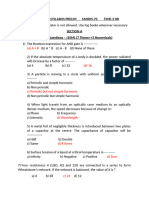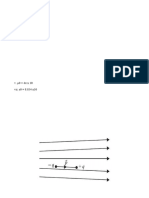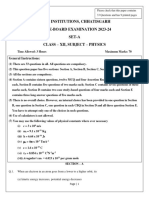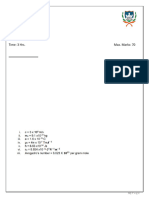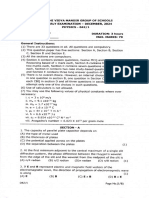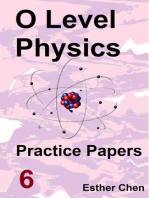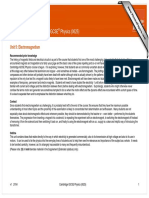1st practice
1st practice
Uploaded by
swarajshinde.gamesCopyright:
Available Formats
1st practice
1st practice
Uploaded by
swarajshinde.gamesCopyright
Available Formats
Share this document
Did you find this document useful?
Is this content inappropriate?
Copyright:
Available Formats
1st practice
1st practice
Uploaded by
swarajshinde.gamesCopyright:
Available Formats
SHARDASHRAM VIDYAMANDIR JR.
COLLEGE OF (SCI-VOC)
CLASS:-SYJC FIRST GENERAL PRACTICE PAPER MARKS:-70
SUBMISSION DATE:-25/12/2024 SUBJECT:-PHYSICS TIME:-3 HOURS
1. Question Paper consists of 31 questions divided into four sections, namely A, B, C and D
(1) Section A: Q. No. 1 Contains 10 Multiple choice type of questions
carrying on mark each.
Q. No. 2 Contains 8 very sort answer type of question
carrying on mark each
(2) Section B: Q. No. 3 to Q. No 14 Contains 12 short answer type of question
carrying Two mark each (Attempt any 8)
(3) Section C: Q. No. 15 to Q. No 26 Contains 12 short answer type of question
carrying Three marks each (Attempt any 8)
(4) Section D: Q. No. 27 to Q. No 31 Contains 5 long answer type of questions
carrying four marks each (Attempt any 3)
2. Use of log table is allowed. Use of calculator is not allowed.
3. Figures to the right indicate full marks.
4. For each MCQ, correct answer must be written along with its alphabet. e g: (a)…../
(b)…./ (c)…../(d)….
5. Evaluation of each MCQ would be done for the first attempt only
6. Physical constat
(i) Mass of Electron, me = 9.1 × 10-31 kg
(ii) ε◦ = 8.85 × 10-12 C2/Nm2
(iii) π = 3.142
(iv) Charge on electron, e = 1.6 × 10-19 C
(v) µ◦ = 4π × 10-7 Wb/Am
(vi) Plank’s constant, h = 6.63 × 10-34 J.s
(vii) Speed of light ,c =3 × 108 m/s
(viii) g = 9.8 m/s2
(ix) Rydberg’s constant, RH = 1.097 × 107 m-1
(x) Stefan’s constant, σ = 5.67 × 10-8 J/m2.s.K4
SECTION A
Q.1 Select and write the most appropriate answer from the given alternatives for each
questions. (10 M)
1) A simple harmonic oscillator has amplitude 16 cm and period 4 s. The least time for it to
travel from x= 16 cm to x= 8 cm is
(a) 1/2 s (b) 2/3 s (c) 5/6 s (d) 4/3 s
2) A small piece of metal wire is dragged across the gap between the pole pieces of magnet in 0.5
second. The magnetic flux between the pole pieces is 8 × 10-4 weber. The emf induced in the
wire is
(a) 1.6 millivolt (b) 16 millivolt (c) 1.6 volt (d) 16 volt
3) When standing waves are produced on a string fixed at both ends,
(a) all particles vibrate in phase
(b) all antinodes vibrate in phase
(c) all alternate antinodes vibrate in phase
(d) all particles between two consecutive antinodes vibrate in phase.
4) If the frequency of incident light falling on a photosensitive material is doubled, then kinetic
energy of the emitted photoelectron will be
(a) the same as its initial value (b) two times its initial value
(c) more than two times its initial value (d) less than two times its initial value
5) A thin-walled hollow sphere, the ratio of the translational KErotational : KEtranslational : KEtotal is
(a) 1: 1: 2 (b) 1: 2:3 (c) 1: 1: 1 (d) 2: 1: 3
6) In the Bohr model of an atom, which of the following ia an integral multiple of h/2π ?
(a) Kinetic energy (b) Radius of the atom
(c) Potential energy (d) Angular momentum
7) Y = 𝑨 + 𝑩 is the Boolean expression for
(a) OR gate (b) AND gate (c) NOR gate (d) NAND gate
8) For a series LCR circuit, the phase difference between the voltage and the current is 45º. The
power factor of the circuit is
(a) 0.607 (b) 0.707 (c) 0.808 (d) 1
9) An LED emits visible light when its
(a) junction is reverse-biased (b) depletion region widens
(c) holes and electron recombine (d) junction becomes hot
10) Magnetic susceptibility is positive and small for
(a) silver (b) platinum (c) mercury (d) sodium chloride
Q.2 Answer the following (8 M)
1) State Ampere’s circuital law.
2) Explain the Stefan-Boltzmann law.
3) Calculate the moment of inertia of a uniform disc of mass 10 kg and radius 60 cm about an
axis perpendicular to its length and passing through its centre.
4) Define Binding energy of an atomic electron.
5) State zeroth law of thermodynamics.
6) State the principle of superposition of waves.
7) What is Angle of contact.
8) Calculate the minimum energy required to take an electron from the ground stste to the first
excited state in hydrogen atom.
SECTION B
Attempt Any Eight of the following (16 M)
Q.3 Explain the working of an LED.
Q.4 Distinguish between potentiometer and voltmeter.
Q.5 The photoelectric work function for a metal is 4.2 eV. Find the threshold wavelength.
Q.6 Write a note on free expansion in a thermodynamic process.
Q.7 A 100Ω resistor is connected to a 220 V/ 50Hz supply. Calculate (a) the rms value of the
current (b) the net power consumed over one full cycle.
Q.8 Obtain an expression for the magnetic induction of a toroid of N turns about an axis passing
through its centre and perpendicular to its plane.
Q.9 State the de Broglie hypothesis and the corresponding equation.
Q.10 The emf of a cell is balanced by a length of 320 cm of a potentiometer wire. When the cell
is shunted by a resistance of 50Ω, the balancing length is reduced by 20 cm. Find the
internal resistance of the cell.
Q.11 Explain why the equivalent inductance of two coil connected in parallel is less than the
inductance of either coil.
Q.12 Obtain an expression for the equivalent capacitance of two capacitors C1 and C2 connected
in series.
Q.13 The half-life of a radioactive species is 3.2 days. Calculate its decay constant (per day).
Q.14 State any two limitations of Bhor’s atomic model.
SECTION C
Attempt any eight of the following (24 M)
Q.15 Derive an expression for the effective capacitance of three capacitors connected in series.
Q.16 State and explain prevost’s theory of heat exchange.
Q.17 Calculate the magnitude of the magnetic field at a distance of 3 cm from a very long
straight wire carrying a current of 6 A.
Q.18 Explain the phenomenon of surface tension on the basis of molecular theory.
Q.19 Define dc and βdc. Obtain the relation between them.
Q.20 Derive Malus’s Law.
Q.21 The wavelength of two sound waves in air are 82/173m and 82/171m. They produce 9 beats
Per second when sounded together. Calculate the velocity of sound in air.
Q.22 Explain the forward and the reverse characteristic of a Zener diode.
Q.23 Explain the use of a potentiometer to determine the internal resisitance of a cell.
Q.24 A coil of resistance 5Ω and itself inductance 4H is connected in series with a variable
capacitor across a 10 Vrms , 50 Hz supply. At what capacitance will occur? Find the
corresponding current.
Q.25 Explain the experimental setup of photoelectric effect.
Q.26 An alternating voltage given by e= 140sin(314.2 t) is connected across a pure resistance of
50 Ω. Calculate (a) the frequency of the source (b) the rms current through the resistor.
SECTION D
Attempt any three of the following (12 M)
Q.27 Obtain the expression for the period of a magnet in angular simple harmonic oscillations
In a uniform magnetic field.
Q.28 Describe the construction of a simple ac generator and explain its working.
Q.29 Show that all harmonics are present in the vibrations of the air column in a pipe open at
both ends.
Q.30 Derive expression for linear velocity at the lowest position, midway position and topmost
position for a particle revolving in a vertical circle if it has to just complete the circular
motion without the string slackening at the top.
Q.31 Using the geometry of the double-slit experiment, derive the expression for fringe width of
interference bands.
You might also like
- 12th Prelim Paper22-23Document5 pages12th Prelim Paper22-23Kanchan AgasheNo ratings yet
- Physics Q Paper HSC Apr 2021 Kubal AcademyDocument4 pagesPhysics Q Paper HSC Apr 2021 Kubal AcademyRAVINDRA WAYKOLENo ratings yet
- Physics Prelim questionDocument4 pagesPhysics Prelim questionankitasyadav777No ratings yet
- PHYSICS 12th Sci Prelim Question PaperDocument4 pagesPHYSICS 12th Sci Prelim Question PaperAditya Deshmukh0% (1)
- Physics Practice Paper - IDocument3 pagesPhysics Practice Paper - Imehul yoNo ratings yet
- Physics (QP) 4Document4 pagesPhysics (QP) 4asifshaikh969933No ratings yet
- Set A-PCMDocument4 pagesSet A-PCMatharv.shinde2216No ratings yet
- 12-phy-Model ques paper-14-QPDocument6 pages12-phy-Model ques paper-14-QPtechnicaljukeNo ratings yet
- XII PHYSICS PRELIM PAPERDocument12 pagesXII PHYSICS PRELIM PAPERtusharvaibhav17No ratings yet
- PHYSICS- Preliminary exam -24-25 (1)Document10 pagesPHYSICS- Preliminary exam -24-25 (1)vayestreyaNo ratings yet
- Physics Prelimis 2 70mDocument5 pagesPhysics Prelimis 2 70mpatelakshi419No ratings yet
- Chandrabhan Sharma Junior College of Science and CommerceDocument4 pagesChandrabhan Sharma Junior College of Science and Commercenaveenkenchgunde10No ratings yet
- Physics DSLSDocument4 pagesPhysics DSLStwilightgaming26No ratings yet
- Physics DSLSDocument4 pagesPhysics DSLSvedantkawatkar123No ratings yet
- Top 10 Sample Papers Class 12 Physics With Solution-1Document153 pagesTop 10 Sample Papers Class 12 Physics With Solution-1Dennis Rosario JNo ratings yet
- 12th Physics SQP SET 1Document12 pages12th Physics SQP SET 1muhammedrehan7777No ratings yet
- Physics QP 1Document4 pagesPhysics QP 1Aseem JamadarNo ratings yet
- PHYSICS Que Paper Set 2Document5 pagesPHYSICS Que Paper Set 2mansigiri287No ratings yet
- Phy Full Prelim 2Document4 pagesPhy Full Prelim 2patelakshi419No ratings yet
- IAS Previous Year Test PapersDocument4 pagesIAS Previous Year Test PapersRavinder Singh100% (2)
- ModelPapers MODELPAPER10 Physics12Document1 pageModelPapers MODELPAPER10 Physics12Maulik KarasaliyaNo ratings yet
- Physics Practice Question Paper 3Document7 pagesPhysics Practice Question Paper 3Puvi neshiNo ratings yet
- 12th HSC Physics Set - I QPDocument3 pages12th HSC Physics Set - I QPΑαdyα PυrαndαrεNo ratings yet
- XII-Physics Set-ADocument7 pagesXII-Physics Set-AAakash GoelNo ratings yet
- Board's Question Papers 2021Document19 pagesBoard's Question Papers 2021subtractnewNo ratings yet
- Physics Pre-Board 1Document11 pagesPhysics Pre-Board 1riyanbindal16No ratings yet
- XII_PHY_PB1_QP_SET ADocument8 pagesXII_PHY_PB1_QP_SET Asiddharth sasidharanNo ratings yet
- 1 - FULL PORTION - BOARD Theory PaperDocument5 pages1 - FULL PORTION - BOARD Theory Paperbbfnpsy2cdNo ratings yet
- 1ST Term Xii Physics 2021Document12 pages1ST Term Xii Physics 2021RiyazNo ratings yet
- Physics grade 12 TERM 1 QUESTION PAPERDocument9 pagesPhysics grade 12 TERM 1 QUESTION PAPERShivendra YadavNo ratings yet
- PHYSICS Que Paper Set 1Document6 pagesPHYSICS Que Paper Set 1niyati.p240No ratings yet
- Xii Physics Set-ADocument9 pagesXii Physics Set-AAshik Anamic ShimiyaNo ratings yet
- MG-32,EG-31Document3 pagesMG-32,EG-31arhamnadeem0pNo ratings yet
- XII_QP_Physics_CPB_P2_2k24Document12 pagesXII_QP_Physics_CPB_P2_2k24johnallan679No ratings yet
- Topper Sample Paper 2 Class XII-PhysicsDocument5 pagesTopper Sample Paper 2 Class XII-PhysicsAbhishek RawatNo ratings yet
- 12th Paper Physics PDFDocument4 pages12th Paper Physics PDFchopadetanushreeNo ratings yet
- DownloadDocument3 pagesDownloadarnavsawarkar0No ratings yet
- MSBSHSE Class 12 Physics Question Paper 2020Document9 pagesMSBSHSE Class 12 Physics Question Paper 2020snehatonmare2No ratings yet
- Superposition of Waves + Wave Optics + Atoms & Nuclei + Dual Nature of Radiation & Matter + Semiconductor - BOARD Theory PaperDocument5 pagesSuperposition of Waves + Wave Optics + Atoms & Nuclei + Dual Nature of Radiation & Matter + Semiconductor - BOARD Theory Papershaikhshirin8c62No ratings yet
- 12th Hsc Physics (Mid Term)Document3 pages12th Hsc Physics (Mid Term)jafago5487No ratings yet
- 04 - Physics - July 2007Document6 pages04 - Physics - July 2007Bernardo Gonzalez GarciaNo ratings yet
- Physics 11 THDocument4 pagesPhysics 11 THashishbhalerao670No ratings yet
- Preboard Paper 1 2024 FInal.docxDocument8 pagesPreboard Paper 1 2024 FInal.docxgodgameropopNo ratings yet
- Std XII Physics QP 16.12.2024Document14 pagesStd XII Physics QP 16.12.2024ajeyprasannamirsNo ratings yet
- Ques PaperDocument10 pagesQues Papergupta.sg003No ratings yet
- Final PreannualDocument10 pagesFinal Preannualchetan7113No ratings yet
- XII PhysicsDocument60 pagesXII PhysicsBhavana ShindeNo ratings yet
- 12th 2nd Prlim Physics Test PaperDocument3 pages12th 2nd Prlim Physics Test Paperatharv musaleNo ratings yet
- Model Question Paper Higher Secondary - Second Year - PhysicsDocument6 pagesModel Question Paper Higher Secondary - Second Year - Physicsbindum_9No ratings yet
- CLASS XII Physics UT-II 2024-25Document2 pagesCLASS XII Physics UT-II 2024-25pc790526No ratings yet
- XII- PHYSICS-1st PRE BOARD QP SET 1 (1)Document7 pagesXII- PHYSICS-1st PRE BOARD QP SET 1 (1)batra.vanshika.0312No ratings yet
- 01 - Physics - January 2006Document6 pages01 - Physics - January 2006Bernardo Gonzalez GarciaNo ratings yet
- 12th Phy QP Set 1 To 5Document21 pages12th Phy QP Set 1 To 5Samiullah ShaikhNo ratings yet
- Class XII 2023 2024 Prelims IDocument10 pagesClass XII 2023 2024 Prelims ITanishkha RaajNo ratings yet
- 12th Physics Centum Question Paper English MediumDocument5 pages12th Physics Centum Question Paper English MediumRR XEROX, ShanthinagarNo ratings yet
- Test Paper 9Document7 pagesTest Paper 9rajeshsharma4121No ratings yet
- 12 Rev MCQ Ans KeyDocument9 pages12 Rev MCQ Ans Keyselva.nishanth2006No ratings yet
- Class 12 FCT 4 CBSE FinalDocument6 pagesClass 12 FCT 4 CBSE FinalDerekNo ratings yet
- Vacuum Nanoelectronic Devices: Novel Electron Sources and ApplicationsFrom EverandVacuum Nanoelectronic Devices: Novel Electron Sources and ApplicationsNo ratings yet
- Cambridge International AS & A Level: Physics 9702/42 May/June 2021Document19 pagesCambridge International AS & A Level: Physics 9702/42 May/June 2021Mahebul MazidNo ratings yet
- Worksheet PhysicsDocument42 pagesWorksheet Physicsinfinite onlineNo ratings yet
- Investigatory Project Physics by RonitDocument17 pagesInvestigatory Project Physics by RonitronitsuniyaNo ratings yet
- Radiation Zone ApproximationDocument13 pagesRadiation Zone ApproximationvibhamanojNo ratings yet
- History of Elctronics by Ivy Dilla Btled 3bDocument11 pagesHistory of Elctronics by Ivy Dilla Btled 3bIvy DillaNo ratings yet
- Physics Perfect Score Module (Answer)Document18 pagesPhysics Perfect Score Module (Answer)Muhamad Syafiq Ab Muttalib100% (2)
- Paramagnetic Materials: Types of Magnetic MaterialsDocument4 pagesParamagnetic Materials: Types of Magnetic MaterialsRaghu BujjiNo ratings yet
- Electromagnetic TheoryDocument13 pagesElectromagnetic TheoryAbhigyan BaruahNo ratings yet
- 2nd Year Physics CH Wise 2021 by 786 AcademyDocument10 pages2nd Year Physics CH Wise 2021 by 786 AcademyKamran Khan100% (5)
- Mini Problem s2 2023Document5 pagesMini Problem s2 2023Annette TageufoueNo ratings yet
- Jee 2014 - Adv - P (I) Qns&Ans 13Document15 pagesJee 2014 - Adv - P (I) Qns&Ans 13britibanerjeeNo ratings yet
- Quiz 1 EM WAVESDocument7 pagesQuiz 1 EM WAVESmagiripeaceNo ratings yet
- Celibacy - Scientific Analysis - Tattva GyanDocument16 pagesCelibacy - Scientific Analysis - Tattva GyanSatadal GuptaNo ratings yet
- ElectrodynamicsDocument364 pagesElectrodynamicsKirk DouglasNo ratings yet
- ch29 PDFDocument29 pagesch29 PDFRodrigo S QuirinoNo ratings yet
- Final One Year Pivot Neet Course Phase - 1 Schedules - Ay 2023-24Document136 pagesFinal One Year Pivot Neet Course Phase - 1 Schedules - Ay 2023-24Prajwal JoshiNo ratings yet
- Volume 3 Issue 2Document7 pagesVolume 3 Issue 2Nandakishore SNo ratings yet
- Physics Laboratory Manual: Shantilal Shah Engineering College, BhavnagarDocument17 pagesPhysics Laboratory Manual: Shantilal Shah Engineering College, BhavnagarSanket PhadNo ratings yet
- M1 TestDocument3 pagesM1 Testsehajpahwa0009No ratings yet
- Unit Test 04 Class 12Document27 pagesUnit Test 04 Class 12nbrk0905No ratings yet
- Intro To MagnetismDocument28 pagesIntro To Magnetismmark gonzales100% (1)
- Template Laporan PraktikumDocument5 pagesTemplate Laporan PraktikumMuhammad HafizhNo ratings yet
- 1988 - Ssce PhysicsDocument197 pages1988 - Ssce PhysicsAbdurrahman Muhammad100% (6)
- Eddy CurrentDocument20 pagesEddy Currentpearl MataiNo ratings yet
- Theory and Application of Density MatrixDocument60 pagesTheory and Application of Density MatrixHasan Rahman100% (1)
- Sas Hp Cr Chap 21 RadovDocument3 pagesSas Hp Cr Chap 21 Radovomkark100008No ratings yet
- Module On Phy 102 Electricity Aug14Document71 pagesModule On Phy 102 Electricity Aug14Denver C CaloniaNo ratings yet
- Scheme of Work - Cambridge IGCSE Physics (0625) : Unit 5: ElectromagnetismDocument5 pagesScheme of Work - Cambridge IGCSE Physics (0625) : Unit 5: ElectromagnetismluyawinNo ratings yet
- Magnetism 3Document18 pagesMagnetism 3VinayKumarNo ratings yet
- PHYC - 2122 4th Quarter ExamDocument22 pagesPHYC - 2122 4th Quarter ExamCelso LoterinaNo ratings yet


















